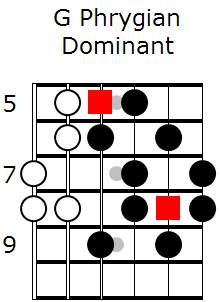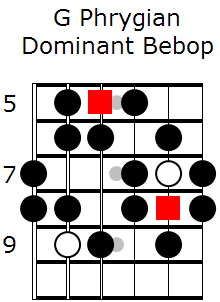Using the Phrygian Dominant Bebop Scale
The Phrygian Dominant Bebop scale is a very common scale choice on the VI7 chord. Just as the Mixolydian Bebop scale is formed by adding a natural 7th to the Mixolydian mode, the Phrygian Dominant bebop scale is formed by adding a natural 7th to the Phrygian Dominant scale.
The Phrygian Dominant scale has the formula 1 b2 3 4 5 b6 b7. When written with the non-arpeggio notes as extensions the formula is 1 b9 3 11 5 b13 b7. Notice the b9 interval? This is why the BDim7/G7b9 arpeggio in the last lesson sounds so good; it is contained in the Phrygian Dominant scale.
Look at the formula again, the Phrygian Dominant mode contains all the notes of a Domi-nant 7 arpeggio (1, 3, 5 and b7) plus some excellent extensions (b9, 11 and b13).
The scale can be played like this on the guitar:
Example 12a:
It is important to know this scale, but for our purposes we again want to create an eight-note bebop scale, which will keep the arpeggio notes on the beat, just as with the Mixolydi-an bebop scale in chapter six. We do this by adding a natural 7th between the b7 and the root.
The formula for the Phrygian Bebop scale is 1 b9 3 11 5 b13 b7 7 and is played like this: (the added ‘bebop’ notes are shown by a hollow dot).
Example 12b:
To begin with, this may feel like an awkward fingering for the scale, however my advice is to stick with it. There are other fingering patterns you can use, but most of them involve jumping out of position to play them cleanly. A little perseverance here will give you great returns in the short term.
We can now begin to use this scale to ‘join the dots’ over the G7 chord. One slight issue is that you may now be used to targeting the b9 on the G7 chord. If you want to use the bebop scale to ‘help’ keep the arpeggio notes on the beat when you play scalic lines, you must treat the root note as the arpeggio note, not the b9.
The b9, as you have heard, does sound great as a target note on the G7 chord, so one way to work with this is to target the b9, but then use a chromatic (bebop) note to place the root back on the beat. More on this later.
Begin by learning the changes between Bb7 and G7 over two-string groups. I’d advise using a Bb7 arpeggio on the Bb7 chord and moving to the Phrygian Dominant bebop scale over the G7 chord to begin with. You can also reverse this so you’re practicing moving from the Bb bebop scale to a G7b9 arpeggio.
Later move on to using bebop scales over both chords.
Here are some examples of melodic lines constructed on the top four strings to get you started. Work through these concepts in your own time and write down as many lines as you can. Keep a diary of what you’re practice and memorise any of your favourite ideas.
Remember to be methodical in your practice too, deliberately begin your lines from the root / b9, 3rd, 5th and b7th of each chord.
Example 12c:
Example 12d:
Example 12e:
Example 12f:
Now let’s add in some chromatic passing notes and patterns. Notice in the first example how I target the b9 of G7 and then use a chromatic passing note to put the root back on the beat.
Example 12g:
Example 12h
This lesson is a sample from my book, Jazz Blues Soloing for Guitar. For more information Click here
“The artists you work with, and the quality of your work speaks for itself.”
Tommy Emmanuel
© Copyright Fundamental Changes Ltd 2025
No.6 The Pound, Ampney Crucis, England, GL7 5SA










